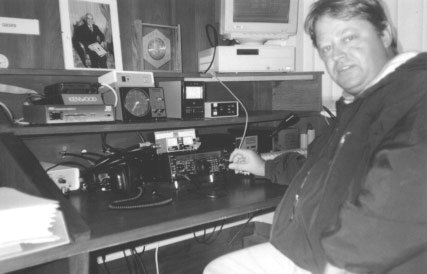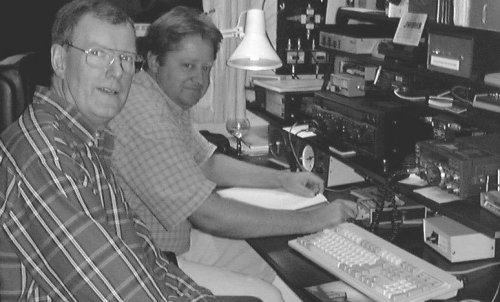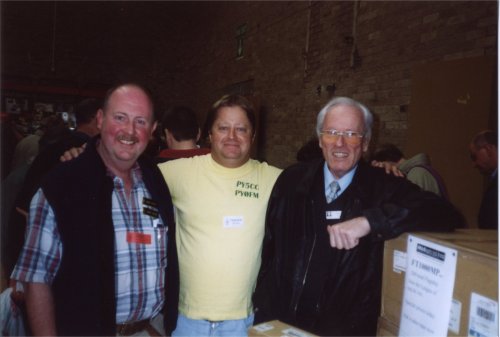Chris: So this is your first time in London, Peter?
Peter: Yes, my first time here.
C: …and what do you think?
P: Great - cold weather, cold beer…
C: What was it like in Curitiba when you left?
P: It's very different. In Curitiba it's cold sometimes but it's very humid. But I do like cold weather, I prefer the cold weather.
C: OK, so you come and live here, we'll go and live in Curitiba, then we can work the DX and you can listen to the noise… (laughter). So, it would be interesting to know something about you, where you live, whether you have a family and so on.

Later in the day we visited RSGB headquarters. Here is Peter in the GB3RS shack.
P: I am living about 100km from Curitiba to the east, on the coast. And I am married with a six-year old daughter, Erika. I work in house construction and also with the Internet, I am a representative of a big Internet provider there. The president of the Internet company is a friend, PY5EG.
Our city is a tourist place, we have three months a year with a lot of tourists, and we have eight or nine months to work on the radio.
C: Is that how it works? Fantastic!
P: Yes. From December until the carnival season more or less is our tourist season. And during that time we have less time to radio. But after that I have the time I need to work six metres.
C: You're lucky.
P: Yes, to work seriously on six metres you need to listen and you need to have much time.
C: Absolutely, so even if you live where you live you have to spend a lot of time listening.
P: Yes, because it is very difficult to hear that there was someone on the band and you didn't work them.
C: When you've `worked everything' it must be very hard if you miss one!
P: Sometimes, you know, I need to go to Curitiba and two times a year I need to go to Fernando de Noronha. I go there for 15 days in October and 15 days in March, we have there a contest station and always when we get time I work a lot of DX. But it doesn't count, it is a separate country.
C: So then you can get 200 from PYØ as well!
P: From PYØ I have 60.
C: Only 60.
P: Maybe one day…
C: Yes, you're in PYØ at very good times for six metres.
P: The last 15 days of March for the CQWPX SSB contest and the last 15 days of October for CQWW contest.
C: And then six metres in between…
P: Yes, of course...
C: So how did you get into amateur radio?
P: I started in 1981, twenty years ago.
A friend of mine had a rig, I visited him, got interested, got my own rig. From
1981 to 1988 I was always on HF - contests, DX etc. But in 1988 a friend of mine, a
G friend, Donald G3MWM, who lived in PY and whose PY call is PY5ZBU,
introduced
me to six metres. He's an electronic engineer, he lived for many years in
Africa and Hong Kong, then he moved to Brazil. He was very keen on six metres.
There's a sad story. Not many people know about that sad story. The story is that guy, in 1989, was the first in the world to work 100 countries confirmed on six metres. The problem was he sent the cards to ARRL and all the card were lost. One or two months later a W was the first to get DXCC on six metres. After that he was so disappointed that he hardly worked six metres ever again. He only comes on the frequency when I call him, he makes the contact and he now has 162 countries confirmed. He is very active on moonbounce. He's a wonderful guy. At that time, we had no Internet [for DX spots]. I think it's really important that everyone should know. The cards were mailed in the US, not Brazil, but the ARRL say they never received the cards.

On his visit to the UK Peter, PY5CC (right) also visited Mike, G3OIL (left).
They are pictured in Mike's shack, from where Peter operated as M/PY5CC.
C: That's terrible…
C: So who was the first PY to get DXCC, was that you?
P: Yes, number 40.
C: And you started in 1989.
P: Yes, I came on in September 89 until October 1989, then I started again in April 1990.
C: And when did you get the DXCC?
P: In 1991. We had a big opening to Africa, I remember that day. I had 94 countries, and then we had a tremendous opening that people called `the big bang'. And that day I worked eight countries more, including A22BW for country 100. I worked Z23JO, A22, 3DA0, hundreds of ZS stations, 7Q7, ZS9, a whole lot of them. With the help of ZS6WB who phoned all the countries, Hal really was fantastic. On that day I also heard the FR beacon, but no-one on that island was active on six metres.
C: So, what equipment do you have now?
P: I am using the FT-847 and the antennas are two eleven-element 2.5 wavelengths by M-squared on one tower, and then on another tower I'm using a nine-element also from M-squared. The higher eleven-element is 21 metres high, the lower one is 15 metres high - six metres apart. The nine-element is at 12m above the ground.
C: Those are good aerials, but you work so much more than anybody else - how do you explain that?
P: I think the location. My location is a very special location. Because we have other PYs living about 100km from me, in Curitiba, and they have the same equipment, the same antennas - I think the location is very important for six metres.
C: And then you have the sea, and you are in the magic spot for six metres.
P: Yes, it's a very special place, like Okinawa, like EA7, like 5B4. I think we have the advantage for the north-south path. But you know, East-West on six metres is very difficult and we don't have the Es kind of propagation. We only work F2 or TEP. I was very interested last year when I was in Slovenia; a friend, S51DI just put a dipole up and I could work everybody. I had never seen anything like that, it's a propagation mode that we don't have where I live. In just an hour I could work everybody and I was very impressed with that.
C: Unfortunately it only goes so far, you know. But maybe that's what's going to get you your contacts to OH, EW and so on, with Es on top of F2.
P: April, May, June, July, August are the best months for us for Europe. Let's see what happens, you never know. My best year for Europe was 1998 - big pileups. We didn't have it in 1999 and 2000 - we had good openings, but not like 1998. It was unbelievable. I have it all recorded on tape and there were big signals, 40 over S9.
C: So what's your technique for operating pileups? You are obviously very experienced at it, on six metres and with the contest station on PY0.
P: Well you just try to pick out the strongest station, maybe just two letters or the full call. I don't like work by numbers; the problem is that you never know when the band will close. You start with number 1 and there's a guy with the number 9, how long is he going to have to wait? What I always do is to stop the pileup sometimes and ask for very difficult areas: anybody from Russia, Scandinavia and so on. You know, we have big signals especially from the South Europe, but maybe there is a G calling or an SM.
C: So what would your advice be to those of us in Europe and in North America who are always at the other end trying to get through to you or to some other rare station?
P: Give your call sign one or two
times each time I call QRZ, and listen, don't call like a crazy thing - that won't help the
DX station. And make it as short as possible; during a big pileup I don't need your
city, I don't need your name and so on. In a pileup I just need your callsign and
the report. And I'd like to ask those people who have worked me before to leave
the opportunity for others. Because there are some stations where I have 10
openings to Europe and I have them 10 times in the log. I want to give the opportunity to
new stations who maybe have not worked Brazil. It can be that after the opening I
check
the log and sixty percent of the contacts are with people that I've worked before.
C: OK, so how do you find the operators at the other end, which countries have the good operators and which have the bad operators?
P: I think you know the answer…
C: That's a good answer - at least I can print it!
P: They are all my good friends, of course!
C: So, you've already said that to work six metres you have to listen a lot, what other techniques do you use?
P: TV video I think is the most
important indicator for us. I have a lot of them
in the memories of the rig and I have a small vertical antenna to listen to them.
Starting with the 45MHz for ZLs and VKs, and then the 48.250 for Spain, 48.242 for
Portugal and also a lot of others from Africa: 5Z, 3C and also from Syria.

A trio of Peters! Peter PY5CC (centre) pictured at the RSGB Convention
with Peter G8BCG/H44PT (left) and Pierre HB9QQ/8Q7QQ (right).
P: Also sometimes the DX is not on the direct path. Most of the DX that I work is not on the direct path. Most of the signals from Europe come from 80 degrees, which is central Africa. It is something that people find a bit hard to believe.
C: Yes all the contacts between the UK and Japan have been way south, maybe 100 degrees when the direct path is more like 30.
P: From PY, on HF the path to Japan is 330 degrees, but on six metres we have these windows around 80 and 260 degrees. It's very important.
C: But you say you have difficulty working East - West.
P: Yes, it's very difficult for us to work ZS, and also for us to work Australia and New Zealand. The only way to work Australia for us is by long path, over Europe. I've only had one short path contact, in 1991, to a VK7 via the South Pole.
C: Over Europe! Which way does the path go, is it over southern Europe? Because if you can hear VK then we should be able to as well.
P: Well during the morning, between 12z and 14z is the time for VKs, and only in April. That was also the time that I worked H44PT, that was a great contact. And that was long path. ZLs we can work short path also around the end of March to early April.
C: I'd love to work long path on Six.
P: You have never?
C: No, not on Six. The 9H1s, Jose EH7 they work ZL and even KH6 by long path - that's a long way!
P: My best DX contact was FR1GZ
long path, about 29,900km. That's my longest distance. We had always tried to work
FR short path. And then one day, one Sun
day, I had a problem with my equipment, a problem with the power switch.
That evening I decided to try to repair the rig.
I switched off the rig and started to work on it. I finished it about 04.20z, that's
about 01.20 for us, a time that I am not normally on the band. I closed up the equipment.
The rig was on 110 at that time, and no one else was on the band so I said
"Hello test, hello test" and I heard "QRZ,
QRZ" and I said "This is Papa Yankee Five
Charlie Charlie, QRZ" then the guy came back "This is Fox Radio One Golf Zulu".
That was something! The trick is, to be in the right place at the right time. If I hadn't
had the problem with the equipment I wouldn't have been on the band at that time.
I worked two FR stations, I've got them on tape, and at that time they had
propagation to Japan and to Hawaii. Ten minutes more propagation and then no more.
I called some other PYs on the phone but the propagation had gone.
C: Amazing. Now, F2 propagation at night is something we just never get.
P: We have it almost every night.
C: It's very frustrating, I tell you, to look at the Internet. The Internet and the cluster are great, but it means that we get more frustrated because we can see what you guys are working!
P: Most days we have F2 into Okinawa, Hawaii and Transequatorial Propagation to the Caribbean and to Europe.
C: So is the FR your favourite contact?
P: I think my favourite contact was a station that I worked in March 1991. I was waiting for the daily TEP opening, I started calling CQ. Then I heard a station "One Alpha Bravo", I said "One Alpha Bravo give me your call", I thought it would be 9H1AB. Then the station came back and said he was not 9H1AB but HZ1AB! My god. That contact was during the gulf war and there was an American there operating the club station. I think he didn't make more than two or three contacts. It was at 21.20z - 21.30z, just as the TEP was starting up. But it took two years to get the card. I sent a card to the manager, K8PYD and he said that he didn't have the log. There was no Internet at that time so it was not so easy to get addresses. I contacted a friend in the US, who said he'd received a letter from a guy who said he had had a contact you on Six. So we were able find out who had been the operator, who had the logs. And then two years later I got the card.
P: Another time, it was May, in 1991 I think. I was watching the Football on the TV and I heard a weak CW signal, my rig is on 24 hours a day either scanning or on 110.
C: What does your wife think of that?
P: She is happy, she prefers that I am at home! So, I heard some weak CW and I found that it was coming from the direction of the Pacific. It was ZK3TPY, Tokelaus. I had never heard it even on HF, that was a fantastic contact. Then I came to 28.885 and confirmed it.
C: You mentioned 28.885, do you still use it?
P: Only from time to time, to say hello to some friends; I like to talk to Eric, G2ADR and Ted, G4UPS who are always on the band. But most of the time I don't have 10m on, I'm listening on six metres. The problem is that if you spend too much time on 10m you aren't on six metres enough!
C: Finally Peter, is there anything you'd like to say to the readers of `Six News'?
P: Enjoy the band, dedicate as much time as possible to six metres, if you don't work a new one now, or in one month, or in one year, try not to get too frustrated.
C: It's hard not to get frustrated..
P: From 1993 to 1997 I didn't work any new countries. But I was on frequency every day. You need to be on every days. 95% listening. A good operator is one who listens, that is the most important.
I read some comments on the cluster that the Ws haven't had any good propagation but according to the last cycle they could start getting the good propagation now. And some areas have good propagation when the cycle starts. From Fernando de Noronha the best time is now, when the cycle is going down.
C: So even when the cycle goes down, you will still be there?
P: Yes, all the time